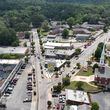In a move of literal and figurative historic proportions, plans call for the Cyclorama to leave Grant Park, its home of more than a century, and relocate to a new facility at the Atlanta History Center in Buckhead.
A surprise in the City Hall announcement Wednesday was that the History Center, having recently completed an unrelated $21.1 million capital improvement campaign, already has raised $32.2 million to showcase the massive, panoramic painting that depicts the Battle of Atlanta.
History Center President and CEO Sheffield Hale said the pledged funds are sufficient to move the painting, construct a 23,000-square-foot building that will be accessible to visitors from its main entrance, conduct an extensive restoration and create an endowment to maintain it.
The Cyclorama painting, one of Atlanta's most treasured cultural artifacts, would remain the property of the city. The History Center and the city still have to reach a long-term license agreement, which Mayor Kasim Reed said would span somewhere between 50 and 75 years. The deal is contingent upon City Council approval, but the mayor said that the assembly has been briefed and he expects its support.
Zoo Atlanta would receive the existing Cyclorama building, with plans to adapt it for administrative offices as well as an events space that will overlook a new habitat area for African elephants.
The proposal would come at no cost to taxpayers, Reed said, and will save the city $500,000 to $1 million annually in facilities maintenance costs and employee salary and benefit costs.
The Grant Park building has housed the Cyclorama since 1921. With restoration of the painting estimated at more than $8 million, the city appointed an advisory group in 2011 to explore options.
The panel — including downtown business leaders, historians, city officials and foundation leaders — recommended three options in 2012. Its top suggestions, all including restoration, were a move to either Centennial Olympic Park, where the College Hall of Fame will soon join a tourism-friendly lineup of attractions, or the History Center, located less than a mile from the heart of the Buckhead business/entertainment district. The third option was for it to remain in Grant Park, where attendance has been on a recent uptick (54,489 in fiscal 2014) but is considered not nearly enough for it to sustain a standalone attraction.
Though Reed and other city leaders had strong interest in relocation to Centennial Olympic Park, the History Center moved to the front when an Atlanta couple, Lloyd and Mary Ann Whitaker, stepped forward offering it a gift of $10 million. That gift will be designated as the painting’s endowment fund.
Once the endowment was secured, the balance of the campaign came with relative speed.
“We have a compelling story, and we have a solution to a problem that has been festering in Atlanta for generations,” Hale said in explaining why he believed donors were willing to commit substantial sums even amid a slowly recovering economy. “People care very much about the Cyclorama, but they did not see a way for ultimate sustainability. This endowment changed that.”
The Whitakers had never been History Center patrons and were not even members, but had been contemplating a legacy gift to the city they have called home for more than five decades. They made the offer after reading a January 2013 story in The Atlanta Journal-Constitution that detailed the various future options for the painting.
Lloyd Whitaker said he was “stunned” when he offered Hale what the couple thought was an original idea over lunch two days after the story appeared, and the History Center leader was ready with the endowment proposal.
They were sure he could get the project done. “He took the bit in his teeth. He raised the money. He got enthusiastic about this,” said Whitaker, 80, president of Newleaf Corp., a Smyrna-based company that provides management and other services to financially distressed companies.
Asked if he fell out of his chair at the offer of what became the quiet campaign’s lead gift, Hale said, “I did. Then I offered to pay for lunch.”
Weighing 9 tons and measuring 42 feet tall and 365 feet in circumference, the Cyclorama, officially titled “The Battle of Atlanta,” is among the world’s largest paintings and is one of only two of comparable size in the United States. The other, depicting the Battle of Gettysburg, is in the Gettysburg National Military Park.
As big as the Cyclorama is, it will get bigger, returning to its original dimensions as parts that were removed when it took up residence in its current home will be re-created as part of the restoration. That includes one panel, 6 feet wide by 50 feet high, depicting an aspect of the battle. Also, 8 feet of sky will be re-created from photographs and added back to the top of the painting, running all the way around its 371-foot circumference.
In total, the History Center will restore 3,268 square feet removed in 1921. Diorama items that were added as part of a Works Progress Administration project in the 1930s, including a wagon and soldier figures, will move with the painting.
Plans call for the History Center to begin the detailed restoration, panel by panel, at Grant Park while the custom-built facility, to be sited between the Centennial Olympic Games Museum and Veterans Park, is under construction.
Construction would begin in summer 2015 and is expected to take a year. Once the building is complete, the painting’s restoration would continue in Buckhead, with the facility open during the process for the public to view. A completion date has not been projected.
Once the painstaking process is complete, the painting will be mounted in its originally designed hyperbolic, or hourglass, shape, restoring the illusion for visitors that they are viewing it in 3-D.
The Cyclorama will be part of the History Center’s regular admission — currently $11 to $16.50.
Another massive artifact, the Civil War locomotive the Texas, which has been displayed with the painting in Grant Park since 1927, will move to the History Center, as well. Though other entities, including the city of Marietta, have expressed interest in the Texas, part of the Great Locomotive Chase, Atlanta leaders feel that it and the painting should remain together.
The painting and locomotive should enhance what is regarded as one of the country's pre-eminent repositories of Civil War artifacts, built around the DuBose Civil War Collection of 7,500 Union and Confederate objects. The History Center's comprehensive exhibit, "Turning Point: The American Civil War," remains on permanent view.
The History Center, which currently attracts more than 220,000 per year, hopes to double attendance over the next decade and believes the Cyclorama could play a big part.
“It clearly heightens our visibility in the community and nationally,” Hale said. “The Cyclorama is an iconic object and it’s beloved in Atlanta. And our ability to bring our collections, programming expertise to bear will give it a new life and add so much to the richness of the History Center. It will make us a must-see place.”
The Cyclorama announcement comes amid a flurry of deals involving city-owned property as the Reed administration searches for cost savings ahead of a 2015 infrastructure bond referendum.
Atlanta officials want to shed costs or burdensome properties that aren’t generating property tax revenue as the city gears up for an expected $250 million bond package. A commission is identifying cost savings for the city to fund debt service on the bonds without raising taxes.
Reed has already moved toward selling the struggling Underground Atlanta complex, the Civic Center and Turner Field once the Atlanta Braves move to their new ballpark in Cobb County. The civilian authority overseeing redevelopment of the defunct Fort McPherson is in negotiations to sell it to filmmaker Tyler Perry.
While the Cyclorama move will benefit the city, the zoo and the History Center, some neighborhood advocates are dismayed.
“They’re taking an asset out of Grant Park,” said historian and community activist Henry Bryant, chair of B*ATL, an annual Battle of Atlanta observance. “It’s just taking an asset we have on the south side and moving it to Buckhead.”
CYCLORAMA HISTORY
1886: Completed by American Panorama Co., Milwaukee
1887: First displayed in Detroit.
1890: Paul Atkinson, of Madison, buys the "Atlanta" for $2,500 and displays it in Chattanooga, Tenn.
1892: Atkinson moves the "Atlanta" to a wooden building on Edgewood Avenue in downtown Atlanta.
1893: Atkinson sells the painting to a Florida businessman.
January 1893: A freak snowstorm caves in the Edgewood structure's roof.
August 1893: The "Atlanta" is sold at auction for $1,100 to collect rent due to the Edgewood property's landlord. Later that year, the painting moves to a wooden structure in Grant Park.
1898: Atlanta businessman George V. Gress gives the Cyclorama to the city.
1921: A new "fireproof" Cyclorama building opens in Grant Park, with a rotunda that is several feet too short in circumference for the complete painting. Historian Wilbur Kurtz wrote that the city utilized a "Procrustean" solution: lopping off several feet of the painting to make it fit.
1979-82: The Cyclorama undergoes a $15 million renovation, which includes building a rotating gallery for the audience.
2008: Restoration of the Gettysburg Cyclorama prompts calls for new restoration and possible relocation of Atlanta painting.
2011-2012: Advisory group's report lays out options for Cyclorama.
2014: 150th anniversary of the Battle of Atlanta.
--Bo Emerson





